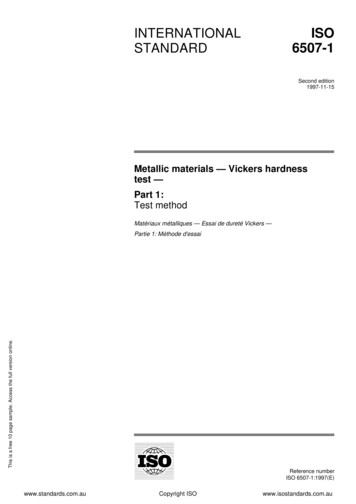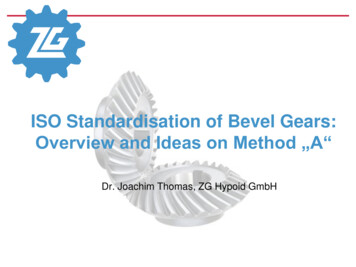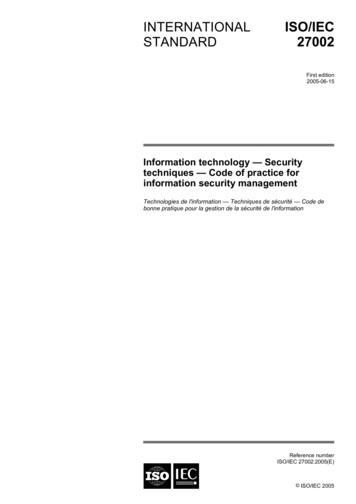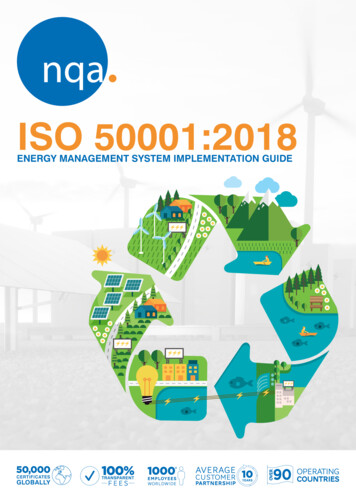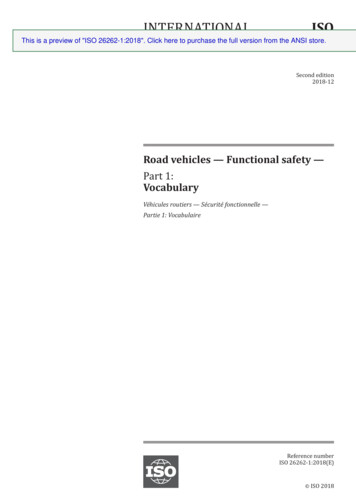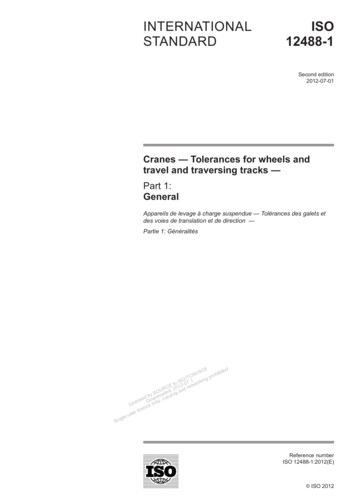
Transcription
INTERNATIONALSTANDARDISO12488-1Second edition2012-07-01Cranes — Tolerances for wheels andtravel and traversing tracks —Part 1:GeneralAppareils de levage à charge suspendue — Tolérances des galets etdes voies de translation et de direction —Partie 1: Généralités.le-gSin8itedSChib96/orCp/TSO -1 kingto I 2-07 etworEC 01 nUR : 2 ndSO aded ing ayod b nl opynse Downly, cecoLinceicelruseReference numberISO 12488-1:2012(E) ISO 2012
ISO 12488-1:2012(E).8itedSChib96/orCp/TSO -1 kingCOPYRIGHT PROTECTED DOCUMENTto I 2-07 etworEC 01 nUR : 2 ndSO aded ing a ISO 2012yoybled owny, coplAll rights reserved. Unless otherwise specified, no ipartpublicationmay be reproduced or utilized in any form or by any means,ens of DthisncoLelectronic or mechanical, including photocopying and microfilm,nce without permission in writing from either ISO at the address below or ISO’seclimember body in the country of the requester.serle-ugnISO copyright officeSiCase postale 56 CH-1211 Geneva 20Tel. 41 22 749 01 11Fax 41 22 749 09 47E-mail copyright@iso.orgWeb www.iso.orgPublished in Switzerlandii ISO 2012 – All rights reserved
ISO 12488-1:2012(E)ContentsPageForeword . ivIntroduction . v1Scope . 12Normative references . 13Terms and definitions . 14Symbols . 25Classification of tolerances . 366.16.26.36.46.5Tolerances . 3General . 3Thermal effects . 3Application of vertical out-of-plane tolerance . 3Construction tolerances . 4Operational tolerances. 4Bibliography . 20.le-gSin ISO 2012 – All rights reserved8itedSChib96/orCp/TSO -1 kingto I 2-07 etworEC 01 nUR : 2 ndSO aded ing ayod b nl opynse Downly, cecoLinceicelruseiii
ISO 12488-1:2012(E)ForewordISO (the International Organization for Standardization) is a worldwide federation of national standards bodies(ISO member bodies). The work of preparing International Standards is normally carried out through ISOtechnical committees. Each member body interested in a subject for which a technical committee has beenestablished has the right to be represented on that committee. International organizations, governmental andnon-governmental, in liaison with ISO, also take part in the work. ISO collaborates closely with the InternationalElectrotechnical Commission (IEC) on all matters of electrotechnical standardization.International Standards are drafted in accordance with the rules given in the ISO/IEC Directives, Part 2.The main task of technical committees is to prepare International Standards. Draft International Standardsadopted by the technical committees are circulated to the member bodies for voting. Publication as anInternational Standard requires approval by at least 75 % of the member bodies casting a vote.Attention is drawn to the possibility that some of the elements of this document may be the subject of patentrights. ISO shall not be held responsible for identifying any or all such patent rights.ISO 12488-1 was prepared by Technical Committee ISO/TC 96, Cranes, Subcommittee SC 8, Jib cranes.This second edition cancels and replaces the first edition (ISO 12488-1:2005), which has been technicallyrevised. It also incorporates the Technical Corrigendum ISO 12488-1:2005/Cor 1:2008.ISO 12488 consists of the following parts, under the general title Cranes — Tolerances for wheels and traveland traversing tracks:—Part 1: General—Part 4: Jib cranes.le-gSiniv8itedSChib96/orCp/TSO -1 kingto I 2-07 etworEC 01 nUR : 2 ndSO aded ing ayod b nl opynse Downly, cecoLinceicelruse ISO 2012 – All rights reserved
ISO 12488-1:2012(E)IntroductionThis part of ISO 12488 establishes requirements and gives guidance and design rules that reflect the presentstate of the art in the field of crane machine design. The rules given represent good design practice that ensuresfulfilment of essential safety requirements and adequate service life of components. Deviation from theserules normally leads to increased risks or reduction of service life, but it is acknowledged that new technicalinnovations, materials etc. may provide new solutions that result in equal or improved safety and durability.le-gSin ISO 2012 – All rights reserved8itedSChib96/orCp/TSO -1 kingto I 2-07 etworEC 01 nUR : 2 ndSO aded ing ayod b nl opynse Downly, cecoLinceicelrusev
.le-gSin8itedSChib96/orCp/TSO -1 kingto I 2-07 etworEC 01 nUR : 2 ndSO aded ing ayod b nl opynse Downly, cecoLinceicelruse
INTERNATIONAL STANDARDISO 12488-1:2012(E)Cranes — Tolerances for wheels and travel and traversingtracks —Part 1:General1 ScopeThis part of ISO 12488 specifies tolerances for construction assemblies and operational conditions of cranes andassociated crane tracks as defined in ISO 4306-1. The purpose of the requirements in this part of ISO 12488 isto promote safe operation and achievement of the expected life of components by the elimination of excessiveload effects due to deviations or misalignments from the normal dimensions of the structure.Tolerances given are extreme values. The elastic deformations due to load effects are outside the scope of thispart of ISO 12488. These will need to be taken into account at the design stage using other criteria to achievethe intended operation and performance.Specific values for particular crane types are given in other parts of ISO 12488.2 Normative referencesThe following referenced documents are indispensable for the application of this document. For datedreferences, only the edition cited applies. For undated references, the latest edition of the referenced document(including any amendments) applies.ISO 286-2, Geometrical product specifications (GPS) — ISO code system for tolerances on linear sizes —Part 2: Tables of standard tolerance classes and limit deviations for holes and shaftsISO 1101, Geometrical Product Specifications (GPS) — Geometrical tolerancing — Tolerances of form,orientation, location and run-outISO 4306-1, Cranes — Vocabulary — Part 1: General3 Terms and definitionsFor the purposes of this document, the following terms and definitions apply.3.1construction tolerance.8itedSCamount by which a specific dimension is permitted to vary,hib from the assembly of the complete crane96/ resultingorC/Tgpand its tracks, in new, modified, rebuilt or repairedtobuildings,ISO07-1 orkinbefore operational usewCE 012 netURed: 2 andOgSdNOTE 1This applies to new build or repairedorcranes and tracks.a modifiedinyd b nlo opynse Downly, cecoLi by theNOTE 2The amount is given eithernceabsolute value of the difference between the limits of size, or by the allowableicelrgeometric variation.e-usgleSin3.2operational toleranceamount by which a specific dimension is permitted to vary, resulting from the use of the crane and its tracksNOTEThe amount is given either by the absolute value of the difference between the limits of size, or by the allowablegeometric variation. ISO 2012 – All rights reserved1
ISO 12488-1:2012(E)4 SymbolsATolerance of the span, related to the rail centre of travelling or traversing tracks, at each point ofthe track or to the wheel centre of crabs or cranesBTolerance of the horizontal straightness, in ground plan, at each point of the travelling trackbTolerance of horizontal straightness related to a test length of 2 m in ground plan, (sample value)at each point of the rail headCTolerance of straightness related to the height of the crane rail centre at each point of the travellingtrackcTolerance of straightness related to a test length of 2 m (sample value) at each point of height ofthe crane railaCentre-to-centre distance between the horizontal guide rollers, in longitudinal direction of raileCentre-to-centre distance between two wheels or bogeys, in longitudinal direction of railhFDistance between the top edge of a rail and the bottom edge of horizontal guide rollersSSpan from centre to centre of the rail0/00Angle of inclination expressed as vertical points per horizontal thousandDWheel diameterEHeight tolerance related to opposite measuring points at right angles to each point of the trackFParallelism tolerance of end stops or buffersGAngularity tolerance related to rail cross-section with plane surfaceHFVertical offset of a welded connectionHSHorizontal offset of a rail headKParallelism tolerance of a rail with reference to the webΔDDiameter tolerance for coupled and independently driven crane/cab wheelsΔeTolerance of the wheel base in ground planΔFAlignment tolerance of guide rollers in ground planΔhrHeight tolerance of the points of wheel contactΔNTolerance of parallel offset of the wheels in ground planαFeCibitAxle tolerance of parallelism of guide rollers across 9the6/S trackrohβFAxle tolerance ofϕkAxle tolerance ofϕrAxle tolerance ofτkAxle tolerance parallelism in elevation of the hole (axle camber)τrAxle tolerance of parallelism in elevation of the wheel (wheel camber)bsTolerance of straightness related to a test length of 1 m adjacent to a welded rail jointchTolerance of straightness related to a test length of 2 m adjacent to a welded rail joint2d.8CpO/T 1 rkingoo IS2-07- twthetacrossparallelism of guide rollerstrackEC 01 neUR : 2 ndSO aded ing ayob nl opyparallelism innasedgroundow ly, c plan of the hole (inclination of axis)DencLieocnecparallelism einr lia ground plan of the wheel (inclination of wheel)-usgleSin ISO 2012 – All rights reserved
ISO 12488-1:2012(E)These symbols and their meanings are applicable to all parts of ISO 12488.Where symbols for construction tolerances are also applicable to operational tolerances (e.g. in operatorinstructions), the suffix w is used (e.g. Aw, Bw, Cw, Ew).Where necessary, an additional suffix may be added, for example,Aw1operational tolerance for travelling tracks,Aw2operational tolerances for traversing tracks,Aw3operational tolerances for cranes,Aw4operational tolerances for crabs.5 Classification of tolerancesThe main criterion for determining the class of tolerance is the total amount of travel throughout the life of thecrane; however, system sensitivity shall be considered along with the class of tolerance as given in other partsof ISO 12488.NOTEIn the context of this part of ISO 12488, system sensitivity is considered to be the amount of reaction of the systemin terms of load effect resulting from the tolerance considered as unintentional displacement (see ISO 8686-1:1989, 6.1.5). Inthe case of highly sensitive systems, it could be appropriate to select a higher tolerance class than that shown in Table 1.Table 1 — Tolerance classesLimits of travelling and traversing distanceTolerance classkm150 000 L210 000 L 50 0003L 10 000, for stationary erected tracks4Temporarily erected tracks for building and erection purposesNOTEL is calculated as the product of the normal travel speed and the specified working time of the relevant travel/traversemechanism, either by application of customer specified values or through reference to the classification of the mechanism (seeISO 4301-1).6 Tolerances6.1GeneralThe tolerances for the various classes and parameters shall be as given in Tables 2, 3, 4, 5, 6 and 7.8itedSChib96/orCp/TSO 7-1 orkingto I 2-0beThe tolerances given in Tables 2, 3, 4, 5, 6 and C7Eshallusedforan ambient temperature of 20 C. Where thewteR201 nd naaverage ambient temperature for the operationalofthecranediffers from 20 C, the tolerances shallOU ded: npositiongSaiyd bownlo copyebe adjusted accordingly.s,D nlyenoLicnceecilrse6.3 Application of verticaltolerance-uout-of-planegleSin6.2Thermal effectsThe tolerance Δhr given in Tables 4 and 5 for the vertical out-of-plane displacement of a corner of rail wheel ofa crane or crane crab, and the corresponding tolerances for tracks given in Tables 2 and 3 are valid for rigidstructures travelling or traversing on the rails, i.e. for box beam structures of main girders, crabs or portals.For frames built from open sections, the tolerances used may be one or two classes lower. ISO 2012 – All rights reserved3
ISO 12488-1:2012(E)6.46.4.1Construction tolerancesGeneralThe measurements shall be taken in the unloaded condition with the crane and its associated tracks supportedin the manner in which they will be operated. Tables 2 to 6 show the appropriate tolerances.If technical documentation requires a means for differentiation of the tolerances, a suffix shall be added to thetolerance symbol, corresponding to the relevant table in this part of ISO 12488.EXAMPLE6.4.2A2 is the construction tolerances for travelling tracks as per Table 2.Rail jointsConstruction tolerances shall be in accordance with Table 6.6.5Operational tolerancesThe operational tolerances given in Table 7 shall be measured with the crane in the unloaded condition.NOTETolerances in excess of those shown in Table 7 can result in unacceptable ride characteristics and additionalstresses, leading to increased wear on rails, wheels, guide rollers etc., and possible damage to the supporting structure.If any measurements are beyond the tolerances in Table 7, then investigations should be undertaken by a competentengineer and the appropriate action taken.le-gSin48itedSChib96/orCp/TSO -1 kingto I 2-07 etworEC 01 nUR : 2 ndSO aded ing ayod b nl opynse Downly, cecoLinceicelruse ISO 2012 – All rights reserved
ISO 2012 – All rights reservedTable 2 — Construction tolerances for travelling tracks of tolerance classes 1 to 4Tolerance parameterSymbolADescription withrespect of this tableGraphical representationTolerance of span S ofthe crane rails related torail centre at each pointof travelling trackCPosition of crane rail in ground planTolerance of horizontalstraightness related totest length of 2 000 mm(sample value) at eachpoint of rail headTolerance ofstraightness relatedto height of crane railcentre at each point oftravelling trackTolerance ofstraightness related totest length of 2 000 mm(sample value) at eachpoint of height of cranerailTolerance of heightrelated to oppositemeasuring points at rightangles at each point oftravelling trackHeight of crane rail (axial slope)Class 2Class 3Class 4Unit 3 5 8 12,5Valid for all spansS 16 mValid for all spansS 16 mValid for allspans S 16 mValid for all spansS 16 m [3 0,25(S 16)] [5 0,25(S 16)] [8 0,25(S 16)] [12,5 0,25(S 16)] 10 max. 15 max. 20 max. 25 max.Valid for spansS 16 m, S inmetresValid for spansS 16 m, S inmetresValid for spansS 16 m, S inmetresValid for spansS 16 m, S inmetres 5 10 20 40mm1124mm 5 10 20 40mm1248mm 0,5S S 2 S 4 SS in metresS in metresS in metresS in metresE EmaxE EmaxE EmaxE Emax 5 max. 10 max. 20 max. 40 max.mmHeight of travelling track (lateral slope)mm5ISO 12488-1:2012(E)ETolerance of horizontalstraightness of rail headat each point of travellingtrackClass 1.c8itedSChib96/pro/TCSO -1 kingto I -07 worCE 012 netUR : 2 ndSO ded g aby loa yined wn copens Doonly,ncelicebLicserle-ugSinBTolerance
6Tolerance of parallelismof end stops or bufferson travelling trackat right angles tolongitudinal axis withparallelism symbol //Tolerance of angularityrelated to crane railcross-section at eachpoint of travelling trackwith angularity symbol gSinle-Height tolerance ofpoints of wheel contactof each point of travellingtrackTolerance of parallelismof crane rail to web ateach point of travellingtrackKt min smallest thickness of webPosition in a ground plan (datum symbol in accordance withISO 1101)Graphical representationTolerance parameter.8itedSChib96/orCp/TSO -1 kingto I 2-07 etworEC 01 nUR : 2 ndSO aded ing ayod b nl opynse Downly, cecoLinceicelruseΔhr(seeTable 3)GFSymbolDescription withrespect of this table10 max.e and S in metres,insert e or S,whichever is theleast5 max.e and S in metres,insert e or S,whichever is theleast 0,5t min1,0S or 1,0eS in metresS in metres0,5S or 0,5e 10 max. 8 max.6 SClass 2 0,8SClass 14Table 2 (continued)e and S inmetres, insert eor S, whicheveris the least16 max.1,6S or 1,6e9S in metres 12,5 max. 1,25 SClass 3Tolerance—e and S in metres,insert e or S,whichever is theleast20 max.2,0S or 2,0e12S in metres 16 max. 1,6 SClass 4mmmm0/00mmUnitISO 12488-1:2012(E) ISO 2012 – All rights reserved
Tolerance of span S ofcrab rails related to railcentre at each point oftraversing trackTolerance of horizontalstraightness related totest length of 2 000 mm(sample value) at eachpoint of rail headTolerance of heightrelated to oppositemeasuring points at rightangles at each point oftraversing trackHeight toleranceof points of wheelcontact at each point oftraversing trackbEΔhrDescription withrespect to this tablegSinASymbol ISO 2012 – All rights reservedle-Height of traversing track (lateral slope)Position of crab rail in ground plan (datum symbol inaccordance with ISO 1101)Graphical representationTolerance parameter8itedSChib96/orCp/TSO -1 kingto I 2-07 etworEC 01 nUR : 2 ndSO aded ing ayod b nl opynse Downly, cecoLinceicelruse 2SE EmaxS in metres, validfor S 2 m 1,6SE EmaxS in metres, validfor S 2 m2Valid for all spansS 2m1SΔhr Δhr maxS in metres, validfor S 2 m4 max.1,6Valid for all spansS 2m0,8SΔhr Δhr maxS in metres, validfor S 2 m3,2 max. 8 max.Valid for all spansS 2mValid for all spansS 2m 6,3 max. 4,2 3,2Valid for all spansS 16 mValid for all spansS 16 m1 5 31Class 2Class 15 max.6,3 max.S in metres, validfor S 2 mΔhr Δhr maxΔhr Δhr maxS in metres, validfor S 2 m1,6SValid for all spansS 2m3,2 12,5 max.S in metres, validfor S 2 mE Emax 3,2SValid for all spansS 2m 6,34Valid for all spansS 16 m 12,5Class 41,25SValid for all spansS 2m2,5 10 max.S in metres, validfor S 2 mE Emax 2,5SValid for all spansS 2m 52Valid for all spansS 16 m 8Class 3ToleranceTable 3 — Construction tolerances for traversing tracks of tolerance classes 1 to 4mmmmmmmmUnitISO 12488-1:2012(E).7
8NOTETolerance of angularityrelated to crab rail crosssection at each pointof traversing track withangularity symbol le-KTolerance of parallelismof end stops or bufferson traversing trackto right angles tolongitudinal axis withparallelism symbol //gSin(seeNote)GFSymbolDesc
The main criterion for determining the class of tolerance is the total amount of travel throughout the life of the crane; however, system sensitivity shall be considered along with the class of tolerance as given in other parts . ISO 12488-1:2012(E) 6




